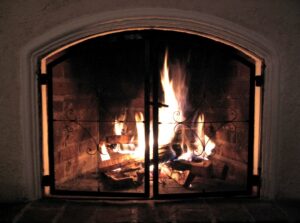Every year over 35% of residential fires are caused by heating sources. Many of them are due to creosote buildup in fireplace chimneys and stovepipes. Having a fireplace or a wood burning stove adds charm to a home and can be a great heating element, but they come with a lot of responsibility. You need to keep them clean, know what to burn and what not to burn in them, know how to burn those materials and how to store them. It takes every piece of that knowledge to make sure you’re protecting your home and its company while they’re in use.
Keeping wood stoves and fireplaces safe starts with a yearly inspection and chimney sweep. Make sure the specialist you hire is certified to perform their services. It’s always good to do a little research on how long they’ve been in business, any unresolved complaints that may be filed against them, and by following up with some of their current references. Don’t forget to also ask about their business liability insurance.
The next part of keeping stoves and fireplaces in great shape is then using them properly. To help keep the creosote from building up inside your fireplace chimney keep the glass doors open while the fire is burning, but don’t forget to keep them closed when the fire is out. Have a screen cover in front the fireplace to protect the surroundings from sparks and stray embers. You may even want to slightly crack a nearby window while using it to keep good air flow. When it comes to avoiding creosote buildup with wood stoves keep air inlets open and make sure not to restrict the air supply. Whether fireplace or stove, place a nonflammable rug in front so that if a spark does escape it doesn’t damage your floor.
Knowing how to build and tend to a fire is crucial for safety and maintenance. Build your fires small with seasoned hardwoods for fireplaces and seasoned wood pellets for pellet stoves. Never use trash, plastic or any cardboard as burning materials. Fires should be built on a grate for support and towards the rear of the fireplace. First place in the kindling and logs and then open the damper. Before you light your fire, an easy way to make sure the smoke will properly escape up the chimney is by quickly blowing out a lit match and watching where the smoke travels. Never start a fire with flammable liquids, and only use your fireplace tools to handle burning logs.
Fireplace and wood stove safety doesn’t end inside of the home. Protecting the exterior of your home involves proper storage of your burning materials, proper disposal of ashes and landscape maintenance. Place your firewood rack 30’ from your house. Keep the ventilation areas clear by trimming any branches around the flues, vents and/or the chimney. You can put a mesh screen to cover the chimney and it will protect the roof from any stray sparks. Vent pipes should be at least 3’ beyond your roof line. Did you know it can take up to three days for fire ashes to completely cool? When finally ready to remove them make sure you open the damper and a window so that rustled ash will be sent up the chimney with the negative air pressure, and then keep the removed ashes contained in a metal container at least 10’ from any structure.
Last but most importantly, test your smoke detectors on every floor monthly and don’t forget to change the batteries once a year. Need help with friendly reminders on that? Follow any of our social media accounts and we’ll post when it’s time.
So when your system is clean, the area maintenance is done, you have the correct burning materials properly stored, and all other safety measures are in place you’re good to go. It may sound like a bit of work but it is all completely necessary to protect your home from suffering a fire damage, smoke and soot damage. The best part you can then reap the rewards of all your efforts and cozy up to a nice toasty fire on one of these chilly nights. ‘Tis the season and I hear it’s going to be a cold week. Enjoy!
